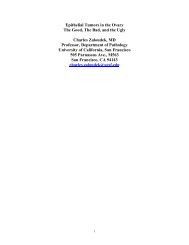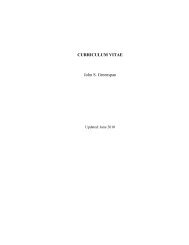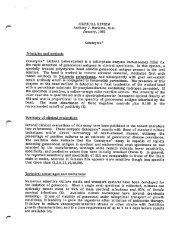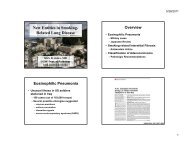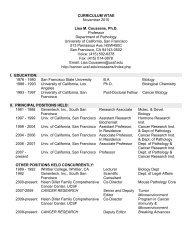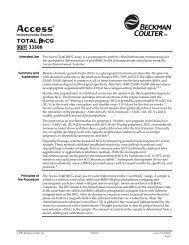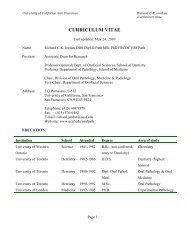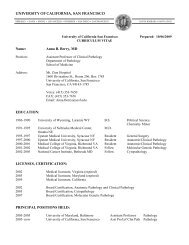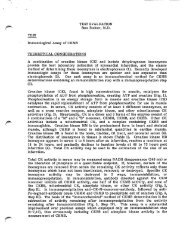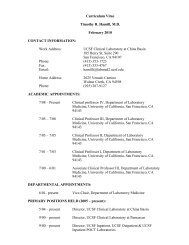ucsf medical center department of pathology neuropathology unit
ucsf medical center department of pathology neuropathology unit
ucsf medical center department of pathology neuropathology unit
You also want an ePaper? Increase the reach of your titles
YUMPU automatically turns print PDFs into web optimized ePapers that Google loves.
UCSF MEDICAL CENTER<br />
DEPARTMENT OF PATHOLOGY<br />
NEUROPATHOLOGY UNIT<br />
SHORT-TERM VISITING FELLOWSHIP<br />
ORIENTATION MANUAL<br />
M-551<br />
505 Parnassus Avenue<br />
San Francisco, CA 94143-0102<br />
Phone: 415-476-5236<br />
Updated: July 1, 2010<br />
Director: Arie Perry, MD<br />
FACULTY<br />
Andrew W. Bollen, DVM, MD Han Sung Lee, MD<br />
Stephen DeArmond, MD, PhD Marta Margeta, MD, PhD<br />
Eric Huang, MD, PhD Joanna Phillips, MD, PhD<br />
Tarik Tihan, MD, PhD
Table <strong>of</strong> Contents<br />
Introduction & Objectives 3<br />
Faculty & Important Phone numbers 4<br />
Schedule <strong>of</strong> Meetings & Conferences 4<br />
Learning Objectives for Everyone 5-8<br />
Teaching Sets 9<br />
Reference Textbooks 9<br />
Standard Procedures<br />
Frozen section procedures 10<br />
Processing <strong>of</strong> stereotactic biopsies 11<br />
Processing muscle/nerve biopsies 12<br />
Reporting <strong>of</strong> Temporal lobe resections 13<br />
Campus Map 14<br />
2
SHORT-TERM VISITING FELLOWSHIP<br />
IN SURGICAL NEUROPATHOLOGY<br />
INTRODUCTION<br />
This manual is intended to orient you to your rotation in Surgical Neuro<strong>pathology</strong>.<br />
Below, you will find the rotation objectives as well as information on resources, routine<br />
procedures, and our Unit. For the purposes <strong>of</strong> this document, all individuals rotating in<br />
Surgical Neuro<strong>pathology</strong> for 1-2 months are identified as Short-Term Visiting Fellows.<br />
Please contact the neuro<strong>pathology</strong> administrative assistant, Ms. Gretchen Werner<br />
(gretchen.werner@<strong>ucsf</strong>medctr.org , phone:415-476-5236) for assistance with<br />
schedules or other questions.<br />
Welcome to Surgical Neuro<strong>pathology</strong>!<br />
The objectives <strong>of</strong> this rotation almost entirely depend on the<br />
individual and his/her aspirations. Nevertheless, we recognize four<br />
main categories:<br />
1- To develop a fundamental understanding <strong>of</strong> Neuro<strong>pathology</strong><br />
practice and mechanisms <strong>of</strong> Neurological Diseases (mostly for<br />
<strong>medical</strong> students)<br />
2- To acquire the fundamental Neuropathological competencies for<br />
the practice <strong>of</strong> Pathology, Neurology, or Neurosurgery (mostly<br />
for <strong>pathology</strong> residents and residents <strong>of</strong> Neurology and<br />
Neurosurgery <strong>department</strong>s)<br />
3- To develop advanced skills and competencies in the field <strong>of</strong><br />
Neuro<strong>pathology</strong> (for practicing pathologists or fellows).<br />
4- To pursue a specific research project in Surgical<br />
Neuro<strong>pathology</strong>.<br />
Pick yours!<br />
3
8 am<br />
9 am<br />
Faculty, Staff & Important Phone numbers:<br />
PERSONNEL Office Phone Pager E-mail<br />
Administrative Assistants<br />
Gretchen Werner M551 476-5236 gretchen.werner@<strong>ucsf</strong>medctr.org<br />
Faculty<br />
Andrew W Bollen M553 502-6605 443-4030 andrew.bollen@<strong>ucsf</strong>.edu<br />
Stephen DeArmond Mission 476-5236 443-6250 stephen.dearmond@<strong>ucsf</strong>.edu<br />
Eric Huang VAMC 221-4800 804-5984 eric.huang@<strong>ucsf</strong>.edu<br />
Han Sung Lee VAMC 476-5236 hansung.lee@<strong>ucsf</strong>medctr.org<br />
Marta Margeta Mission 514-0228 443-6413 marta.margeta@<strong>ucsf</strong>.edu<br />
Arie Perry S564B 476-4961 443-6304 arie.perry@<strong>ucsf</strong>.edu<br />
Joanna Phillips Parn 476-4758 443-1988 joanna.phillips@<strong>ucsf</strong>.edu<br />
Tarik Tihan M551 514-9332 443-1390 tarik.tihan@<strong>ucsf</strong>.edu<br />
Fellows 2009 & 2010<br />
Michelle Madden(1 st yr) M551 502-6604 443-8553 michelle.madden@<strong>ucsf</strong>medctr.org<br />
Michael Barnes (2 nd yr) 1450.3rd 514-1184 443-3265 Costello Lab<br />
Important Phone Numbers<br />
Surgical Path Gross Rm M580 353-1608 Supervisor David Chang<br />
Immuno<strong>pathology</strong> M567 353-1623 Supervisor Ann Hariri<br />
Electron Microscopy S568 353-2673 Supervisor Glenda Reifenrath<br />
Morgue M55 353-1629 Supervisor Mel Abulencia<br />
Schedule <strong>of</strong> Meetings & Conferences:<br />
Monday Tuesday Wednesday Thursday Friday<br />
Resident<br />
Lecture<br />
Autopsy<br />
Gross<br />
Conference<br />
9:15: Consultant/<br />
Consensus<br />
Conference M557<br />
Resident<br />
lecture<br />
Neuro Autopsy<br />
M55<br />
M.O.D.<br />
Conference<br />
Neuroradiology<br />
Conference<br />
N721<br />
10 am<br />
11 am<br />
12 pm Neurooncology<br />
1 pm<br />
2 pm<br />
3.30-<br />
5 pm<br />
5 pm<br />
Tumor Board<br />
L33 12.30 pm<br />
Neuro<strong>pathology</strong> Sign-out Sessions (ask for location)<br />
Department-wide functions<br />
Resident<br />
lecture<br />
Muscle/<br />
Nerve Conf<br />
M557<br />
Virchow<br />
Rounds<br />
4
Learning Objectives for Neurology/Neurosurgery Residents:<br />
1. Learn how the neuropathologist works<br />
2. Learn what to expect from frozen section and when frozen<br />
section can be useful<br />
3. Learn the grading and typing <strong>of</strong> brain tumors and learn about<br />
radiology/<strong>pathology</strong> correlation<br />
4. Learn the basic pathological patterns in nerve and muscle<br />
biopsies<br />
5. Learn the spectrum <strong>of</strong> clinically relevant CNS infections<br />
6. Learn the principals <strong>of</strong> pathological findings in demyelinating<br />
diseases<br />
7. Learn the fundamental pathological findings in<br />
neurodegenerative diseases<br />
8. Learn how autopsy neuro<strong>pathology</strong> can help discovery,<br />
research and patient care<br />
9. Learn about the basic images that can be encountered in the<br />
neurology/neurosurgery board exams<br />
10. Develop knowledge for neuroscience research.<br />
REQUIRED READING: Manual <strong>of</strong> Basic Neuro<strong>pathology</strong> (Grey, DeGirolami and<br />
Poirier): To review the fundamentals <strong>of</strong> neuro<strong>pathology</strong> for residents in neurology<br />
and neurosurgery. just ask Gretchen Werner and sign out the book!<br />
Recommended Textbooks<br />
1. Practical Review <strong>of</strong> Neuro<strong>pathology</strong> (Fuller, Goodman): This is an excellent<br />
book for board review. Just browse the tables and the figures if you are pressed in<br />
time. In Dr. TIHAN'S OFFICE M551<br />
2. Neuroradiology Companion (Castillo): This book is great for basic<br />
neuroradiology information. It is very helpful for <strong>medical</strong> students, <strong>pathology</strong><br />
residents and neuropathologists. It is somewhat simplistic for rotating neurology or<br />
neurosurgery residents. In Dr. TIHAN’S OFFICE M551.<br />
3. WHO Classification <strong>of</strong> the Tumors <strong>of</strong> the Central Nervous System (IARC<br />
2007; Eds Louis,Ohgaki,Wiestler,Cavenee): This is the WHO reference book for<br />
classification and typing <strong>of</strong> CNS tumors. It is a great addition to the<br />
Neuropathologist’s library. It is a good reference for Neuro<strong>pathology</strong> fellows,<br />
<strong>pathology</strong> residents and is somewhat extensive for rotating neurology and<br />
neurosurgery residents. Multiple copies in Neuro<strong>pathology</strong><br />
5
Learning Objectives for Medical Students:<br />
To develop a basic concept on the fundamental aspects <strong>of</strong><br />
Neuro<strong>pathology</strong><br />
1. How to perform a frozen section, intraoperative smear and how to<br />
proceed with an intraoperative consultation<br />
2. How approach a surgical neuro<strong>pathology</strong> specimen and develop a<br />
general algorithm in making diagnosis<br />
3. Understand the major groups <strong>of</strong> primary brain tumors, the concept <strong>of</strong><br />
gliomas, grading and classification <strong>of</strong> most common tumors in the<br />
WHO scheme.<br />
4. Understanding useful stains to determine origin <strong>of</strong> tumors and correct<br />
diagnosis<br />
5. Learn the most common entities in demyelinating disorders<br />
6. Learn the fundamental concepts <strong>of</strong> cranial trauma, fractures,<br />
intracranial hemorrhages and herniations.<br />
7. Learn the most common cerebrovascular disorders (aneurysm,<br />
malformations, ischemic/hypoxic encephalopathy)<br />
8. Learn the most common (three <strong>of</strong> each) bacterial, fungal, parasitic<br />
and viral infectious agents<br />
9. Learn the diagnostic criteria for most common neurodegenerative<br />
diseases (AD, PD, ALS)<br />
10. Learn the 4 stages <strong>of</strong> neurodevelopment and four most common<br />
disorders at all four stages <strong>of</strong> neurodevelopment.<br />
11. Observe the fun we have every day<br />
SUGGESTED READING: Manual <strong>of</strong> Basic Neuro<strong>pathology</strong> (Grey, DeGirolami<br />
and Poirier) just ask Gretchen Werner and sign out the book!<br />
Recommended Textbooks<br />
1. Practical Review <strong>of</strong> Neuro<strong>pathology</strong> (Fuller & Goodman)<br />
This is an ideal book to review the fundamentals <strong>of</strong> neuro<strong>pathology</strong> for <strong>medical</strong><br />
students. Especially the figures and tables are very useful<br />
2. Principle's and Practice <strong>of</strong> Neuro<strong>pathology</strong> (Nelson, Parisi, and Mena): This<br />
book concentrates on material from the AFIP Neuro<strong>pathology</strong> review course. It's<br />
somewhat more in-depth than Fuller and Goodman's little book yet it's still very<br />
readable.<br />
6
Learning Objectives for Pathology Residents:<br />
To master the basics <strong>of</strong> neuro<strong>pathology</strong> practice and learn the most<br />
common disorders that can be encountered in daily surgical<br />
<strong>pathology</strong> practice<br />
1. Learn how to perform and interpret frozen section and smear preparations<br />
2. Develop a fundamental understanding <strong>of</strong> brain imaging CT and MRI<br />
3. Learn the basics <strong>of</strong> how to communicate with the Neurosurgeon and<br />
Neurooncologist<br />
4. Understand how to diagnose and differentiate cavernous angioma and<br />
arteriovenous malformation and other common vascular <strong>pathology</strong>.<br />
5. Understand the basic reactive processes and their routine appearance<br />
6. Learn how to recognize, and grade meningiomas, gliomas, neuronal tumors,<br />
medulloblastoma/PNET, germ cell tumors and lymphomas<br />
7. Recognize the most common 5 mistakes committed in surgical neuro<strong>pathology</strong> and<br />
learn how to avoid them.<br />
8. Learn to recognize a macrophage-rich disorder (demyelinating or infarctive)<br />
9. Learn how to diagnose AD, PD, Lewy body disease, and develop an understanding<br />
on when to refer a case to a specialist.<br />
10. Learn how to use the most common immunohistochemical stains.<br />
11. Learn when electron microscopy is useful in Neuro<strong>pathology</strong>.<br />
12. Learn to recognize neurogenic and myopathic patterns in muscle biopsy, and learn<br />
the most common histochemical stains.<br />
13. Learn to recognize axonal and demyelinating neuropathy and use <strong>of</strong> thick sections<br />
14. Correctly answer most common questions asked in Anatomic Pathology Boards<br />
15. Participate in the social activities and admire the fun we have in neuro<strong>pathology</strong><br />
REQUIRED READING: Basic Neuro<strong>pathology</strong> (Gray,Girolami, Poirier). Basic<br />
Neuro<strong>pathology</strong> can be checked out at the Neuro<strong>pathology</strong> Unit M551, just ask<br />
Gretchen Werner and sign out the book!<br />
Recommended Textbooks<br />
1. Practical Review <strong>of</strong> Neuro<strong>pathology</strong> (Fuller & Goodman)<br />
2. Surgical Pathology <strong>of</strong> the Nervous System and its coverings (Burger,<br />
Scheithauer, Vogel)<br />
3. WHO Classification <strong>of</strong> the Tumors <strong>of</strong> the Central Nervous System (IARC<br />
2007; Eds Louis,Ohgaki,Wiestler,Cavenee)<br />
7
Learning Objectives for Visiting Pathologists/Fellows:<br />
Your objectives and your goals are entirely up to you. We will do<br />
everything we can to help you achieve whatever you would like to do.<br />
Please fill out the objectives section below and pass it onto us so that<br />
we can follow up our progress in having you achieve your goals.<br />
Name:__________________________________<br />
My goals are<br />
1.<br />
2.<br />
3.<br />
4.<br />
5.<br />
8
Teaching Sets:<br />
Surgical Neuro<strong>pathology</strong> Teaching Set<br />
Located in M551. The access is by appointment, and the slides can be checked out on<br />
a daily basis. The information for the teaching set is also available as a FileMaker<br />
document. (Note: There are also a number <strong>of</strong> neuro<strong>pathology</strong> teaching slides within<br />
Surgical Pathology Teaching set kept in Pathology Administration by Christine Lin<br />
Phone: 514-3424)<br />
Total number <strong>of</strong> cases by 2010 =420<br />
Intraoperative Smear Teaching Set<br />
Located in M551. The access is by appointment, and the slides can be checked out on<br />
a daily basis. The information for the teaching set is also available as a FileMaker<br />
document.<br />
Total number <strong>of</strong> cases by 2010 = 75<br />
Stereotactic Biopsy Teaching Set<br />
Located in M551. The access is by appointment, and the slides can be checked out on<br />
a daily basis. The information for the teaching set is also available as a FileMaker<br />
document.<br />
Total number <strong>of</strong> cases by 2010 = 50<br />
Surgical Pathology Teaching Set<br />
Located in the residents room in M578, the slide set includes more than 1000 cases and<br />
covers most <strong>of</strong> surgical <strong>pathology</strong> excluding <strong>medical</strong> kidney and transplant <strong>pathology</strong>.<br />
To access the surgical <strong>pathology</strong> teaching set, please contact one <strong>of</strong> the chief residents.<br />
Reference Textbooks: There are numerous other books in our Unit and in the individual<br />
libraries <strong>of</strong> Drs. Bollen and Tihan. These books can be made available to rotating<br />
fellows/residents with special arrangement. The recommended references include:<br />
1. Basic Neuro<strong>pathology</strong> (Gray, Girolami, Pouirier)<br />
2. Practical Review <strong>of</strong> Neuro<strong>pathology</strong> (Fuller & Goodman)<br />
3. Principles and Practice <strong>of</strong> Neuro<strong>pathology</strong> (Nelson, Parisi, and Mena)<br />
4. Surgical Pathology <strong>of</strong> the Nervous System and coverings (Burger, Scheithauer, Vogel)<br />
5. Pathology & Genetics Tumors <strong>of</strong> the Nervous System (Kleihues & Cavenee 2000)<br />
6. WHO Classification <strong>of</strong> CNS Tumors (Louis, Ohgaki, Cavenee, Wiestler, 2007)<br />
7. Structural & Molecular Basis <strong>of</strong> Skeletal Muscle Disease (Karpati Ed.)<br />
8. Pathology <strong>of</strong> Skeletal Muscle (Carpenter & Karpati)<br />
9. Biopsy Diagnosis <strong>of</strong> Peripheral Neuropathy (Midroni & Bilbao)<br />
10. Greenfield’s Neuro<strong>pathology</strong> (Graham & Lantos)<br />
11. Textbook <strong>of</strong> Neuro<strong>pathology</strong> (Davis & Robertson)<br />
12. Neuroanatomy through Clinical Cases (Blumenfeld)<br />
9
STANDARD PROCEDURES<br />
1. Frozen section procedures: Frozen sections are performed at the<br />
Surgical Pathology Suite in Room M576. The Neuropathologist on-call<br />
is paged to the suite when the resident is called from the O.R. to<br />
retrieve a frozen. You can ask the pathologists assistants to page you<br />
as well, but this has to be arranged individually since there is no strict<br />
obligation that you attend all frozen sections. It is very helpful to do so,<br />
but not practical for all rotators.<br />
2. We need a smear and a frozen section slide for most effective<br />
intraoperative consultation decisions and you should be familiar with<br />
both <strong>of</strong> these procedures. Neuro<strong>pathology</strong> fellows and Anatomic<br />
Pathology resident should be PROFICIENT in doing both.<br />
Note: Always Make sure that you are left with sufficient material for<br />
permanent sections for diagnosis. Subsequent samples from the<br />
patient may not be from the lesion, or still too small for diagnosis.<br />
Total number <strong>of</strong> frozens performed/observed: ______________<br />
10
Processing <strong>of</strong> Stereotactic biopsies:<br />
Stereotactic biopsies are small samples and should be handled with<br />
extreme care. The primary goal <strong>of</strong> interpreting the stereotactic biopsy is to<br />
provide a diagnosis for further management. The biopsy should be<br />
evaluated using an intraoperative evaluation to assess sample adequacy,<br />
and to provide a preliminary diagnosis. You should always observe caution<br />
when processing these biopsies since the tissue is almost always limited.<br />
Never forget to keep a sample for permanent sections. You have the option<br />
<strong>of</strong> doing a smear only or smear and freeze a tiny portion but always check<br />
with your attending.<br />
DO NOT FORGET, a stereotactic biopsy procedure looks like a<br />
regular surgical process unless you notice the stereotactic frame in<br />
patient’s head or ASK! Typically, the patients are awake in such<br />
procedures.<br />
11
Processing Muscle/Nerve Specimens (for Residents):<br />
Muscle and Nerve Biopsies on Evenings and Weekends:<br />
1. Accession the specimen as an NP case.<br />
2. Examine specimen. They are normally received fresh. Measure and record<br />
dimensions and weight for the NP fellow.<br />
2. Place a tiny sliver (~0.2 x 0.1 x 0.1 cm) in chilled glutaraldehyde and store in the<br />
refrigerator.<br />
3. If enough tissue is available (>0.3 gm), submit a small cross-section for formalinfixed,<br />
paraffin-embedded sections. This is particularly important if a vasculitis or<br />
inflammatory myopathy is suspected. Choose fattier/more cauterized or<br />
otherwise distorted portions for formalin-fixation. Always save the best material<br />
for frozen section histochemistry.<br />
4. If the specimen comes with some indication that the muscle biopsy is being done<br />
for metabolic, mitochondrial or biochemical workup and the specimen is >0.4 gm,<br />
snap freeze a small portion in liquid nitrogen without OCT and store this in the<br />
minus 80 centigrade freezer located in the gross room.<br />
5. Wrap remainder in saline-moistened gauze that has been completely wrung out<br />
(no free saline should contact the specimen or severe freezing artifacts will arise)<br />
and store in the fridge.<br />
6. Be sure to save the best material for frozen section histochemistry.<br />
Nerves.<br />
1. Accession the specimen as an NP case.<br />
2. Nerves are normally received fresh. Examine the specimen. Be careful to<br />
handle it by the ends and avoid bending it, if possible. Measure and record<br />
dimensions and appearance.<br />
3. Obtain razor blade from frozen section cutting station and remove the cardboard<br />
wrapping. Make a narrow trough with the cardboard and gently drape the nerve<br />
into the trough. This provides just a little bit <strong>of</strong> tension on the nerve while it fixes.<br />
Fix the specimen on the cardboard in chilled glutaraldehyde, in the refrigerator.<br />
Alert the neuropath fellow on Monday morning and s/he will take care <strong>of</strong> it.<br />
4. In cases where there is serious consideration <strong>of</strong> metabolic disease, it is best to<br />
contact the Neuro<strong>pathology</strong> fellow to discuss appropriate processing: 443-2693.<br />
12
REPORTING OF TEMPORAL LOBE RESECTIONS<br />
Temporal lobe resections are <strong>of</strong>ten performed for the purpose <strong>of</strong> controlling<br />
seizures emanating from this region. The correct orientation and reporting <strong>of</strong> these<br />
resections are critical to diagnosis and subsequent management <strong>of</strong> patients. There is a<br />
optional form for reporting and processing temporal lobe resections for seizures. The<br />
form is accompanied by a set <strong>of</strong> directions for grossing these specimens. These<br />
documents can be found in the I drive within the NEUROPATHOLOGY Folder titled as<br />
“Seizures”. The form in the next page is also designed reporting <strong>of</strong> the temporal lobe<br />
resections (see page 14)<br />
Most temporal lobe seizure specimens contain 4 parts: 1-lateral temporal cortex, 2temporal<br />
lobe, 3-amygdala, 4-hippocampus. Ideally, one should orient the hippocampus.<br />
This is best done with the help <strong>of</strong> the neurosurgeon or attending neuropathologist. It is<br />
also helpful to identify the ventricular surface that is <strong>of</strong>ten much shinier than the rest <strong>of</strong><br />
the specimen. Cortical surfaces can also be easily identified. Coronal sections through<br />
the hippocampus will better visualize the entire anatomy microscopically (as shown<br />
below) in order to assess neuronal loss in the critical areas (dentate gyrus and Cornu<br />
Ammonis (CA).<br />
The specimen may come as a three dimensional tube, which you would serially<br />
cross-section (see below). The smooth, shiny aspect corresponds to the ventricular<br />
surface, which can aid in orientation.<br />
13



